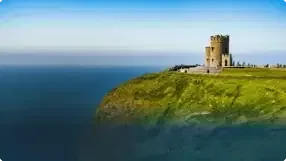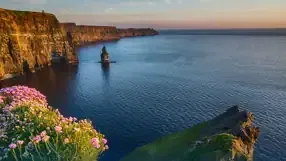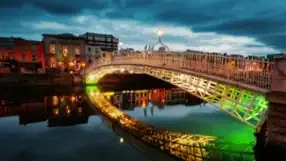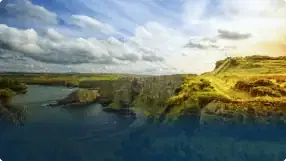Museums and Galleries of Ireland
Learn more about the museums and galleries to tour for those who want to delve further into Ireland's rich culture and history.

The best museums in Ireland

The Museum of Modern Art
Ireland’s leading collection of contemporary and modern art, the Irish Museum of Modern Art (IMMA) opened in the 1990s and has since played a leading role in promoting art awareness and appreciation. Between the museum and the national programmes that are organised through it, the IMMA attracts more than 400,000 visitors each year.
The museum’s permanent collection focuses on Irish artists and features roughly 3,500 works of art. However, the temporary exhibits take a much broader approach to modern art and include work from all over the world. Visit the IMMA Exhibitions page to see what’s on while you’re visiting.
Public tours of the collection are offered from Tuesday to Friday and again on Sunday at 2:30 pm. On Saturdays, tours run at noon and 4 pm. These general tours are free and open to the public. More in-depth guided tours of specific instalments can be booked by appointment.
There’s a gift shop on the ground floor where visitors can pick up books, prints and other materials related to the IMMA collection.
Building and Grounds
The museum is housed in the Royal Hospital Kilmainhem, which is arguably the finest remaining building from its era. The hospital was built in 1684 by the Duke of Ormonde, James Butler. The building was modelled after Les Invalides in Paris and features a prominent façade and a well-manicured courtyard. For its first two and a half centuries, the building housed retired soldiers. The Royal Hospital Kilmainhem was restored in the 1980s and converted to the IMMA a few years later. Get a sneak peek at the IMMA collections by taking a virtual tour on the museum website.

The National Gallery of Ireland
The National Gallery in Dublin is home to more than 14,000 works of art. This includes 5,000 drawings, as many prints and about 2,500 oil paintings. It’s Ireland’s definitive collection of art.
Most impressive are the works by Jack Butler Yeats, brother to the much better-known poet. Much of the painter’s work centred on family members – especially his father, sisters and nieces. A sampling of Yeats’ paintings can be viewed on the gallery’s website.
Irish talent aside, the National Gallery houses a truly international collection. Every major school of painting that came out of Europe between the 1300s and 1900s is represented here. For visitors who would like an express tour of the most popular artwork, visit rooms 1 through 10 for what is known as the ‘Masters of the Collection’ tour. It includes work by Renaissance Painters, Dutch Masters, French Impressionists and artists from Ireland.
One of the most popular pieces in the gallery is Meeting on the Turret Stairs, a watercolour by Frederic William Burton that depicts a momentary, but forbidden, exchange between star-crossed lovers – a princess and her bodyguard. This is a delicate painting and is only open for viewing three times per week: Mondays and Wednesdays (11 am to 12 pm) and Saturdays (3 pm to 4 pm).
The National Gallery is open every day of the year except for Good Friday and 24 to 26 December. Admission is always free, as are guided tours, which meet in the Shaw Room every Saturday (2 pm) and Sunday (1 pm). Additional tours are conducted during July and August on Mondays, Wednesdays and Fridays (2 pm).
Connect with the National Gallery of Ireland through Facebook and learn more about upcoming events and temporary exhibitions through the gallery's official website.

The National Museum of Ireland - Archaeology
The National Museum of Ireland is actually split into four locations, each with its own focus. The museums of Decorative Arts and History, Natural History and Country Life are located variously around the country. However, if you only have time for one, there’s no question that the museum of archaeology is the finest of the lot.
As with so many of Ireland’s national treasures, admission is free. This, no doubt, contributes to the nearly half a million visitors that pass through each year. However, even if the museum did levy an admission fee, it would still be well worth it. These are among the highlights of the archaeology museum:
The Treasury
This is arguably the finest of the museum’s collections, if only because its representative of Ireland and holds artefacts that are rarely found elsewhere in such abundance. The objects on display include pieces from the Iron Age and remnants of Viking culture. This segues into an exhibit that explores the transition from Pagan to Christian cultures, centring on an ancient manuscript of the Book of Psalms. It rounds out with an exhibit of medieval craftsmanship.
Kingship and Sacrifice
A major discovery of Iron Age remains was found in County Offaly in 2003. After this, a team of international specialists converged on Ireland to excavate the area. This exhibition is the culmination of that work, with information about the role that human sacrifice played in royal rites of the Iron Age in Ireland.
Ór – Ireland’s Gold
Bronze Age goldwork is the focus of this exhibit. Before the intervention of the Royal Irish Academy in 1785, anyone who found a bit of crude gold that was thousands of years old would just as soon melt it down than put it on display. Luckily for today’s visitors, the Royal Irish Academy was reasonably successful, and a great deal remains on display for future generations.
Ancient Ireland
It’s fitting that a country with as much prehistory and many ancient artefacts as Ireland would appreciate the same in other parts of the world. These exhibits feature artefacts from the Stone Age through the Middle Ages. The painted sarcophagus of Tentdinebu is a particularly important piece and dates roughly to the 9th century BC.

The National Museum of Ireland - Decorative Arts
Housed in the Collins Barracks in Dublin, this branch of the National Museum of Ireland impresses even before you’ve walked through the front doors. The exhibits focus on the arts, crafts and wares of Ireland – covering everything from Irish coins to the gauntlets of kings.
The barracks building was completed in the early 18th century and was designed by Thomas Burgh, the same architect who worked on the Old Library at Trinity College. The barracks are named for Michael Collins, a freedom fighter who died in the Civil War. In so many words, the building itself is an icon. In fact, few people call it the ‘Decorative Arts and History Museum’. This is the Collins Barracks, regardless of what’s kept inside.
That said, there’s plenty inside to enjoy. On the ground floor is a relatively recent addition to the museum’s permanent exhibits – The Easter Uprising: Understanding 1916. It explores the social, economic and cultural background of the rising, with insight into the politics and personalities behind it. Central to the exhibit is an original copy of the Proclamation of the Republic.
Head to the first floor to see one of the largest collections of silver in the world – and all of it sourced from Ireland. You’ll also find a thousand years’ worth of Irish coins on display on this floor.
The highlight of the second floor is the Irish Country Furniture exhibit. Central to this is a reconstructed Irish country kitchen. There’s another furniture exhibit on the same floor that follows the work of 20th-century designer, Eileen Gray. Up one more floor, The Way We Wore exhibit displays period clothing and jewellery from the 18th through the 20th centuries.

The National Museum of Ireland - Natural History
The National Museum of Ireland has four branches, and this one is known as much for its content as it is for the style in which it is arranged. Some even suggest that the Natural History Museum is actually a museum of museums, as it has been spectacularly maintained in its original Victorian style.
Dr. David Livingstone (of “Dr. Livingstone, I presume” fame) curated this museum before he disappeared into Africa. It’s a stronghold of taxonomy, with more than two million specimens stuffed, mounted or otherwise displayed in the museum. Locals jokingly refer to the natural history museum as ‘The Dead Zoo’. Animals perch at every turn – behind panes of glass, arranged in dioramas, floating in preservatives. It’s quirky and eclectic museum that has remained true to its origins.
The best exhibits are found in the Irish Room, which is populated with a host of indigenous species. There are hundreds of animals on display, but the showpiece is a collection of three Irish Elk skeletons. These beasts would have stood two metres tall at the shoulders, and their antlers alone would have weighed 40 kilograms. The skeletons are roughly 10,000 years old. There are plenty of other exhibits to enjoy. Mammals of the World begins with primates on the first floor and continues with a diverse collection of peculiar creatures. Pandas, Tasmanian tigers and rhinoceroses are all in the mix.
Some of the exhibits on the third floor balcony have been closed pending a safety review. This is one of the downsides of operating a free attraction. The museum is dearly loved but under-funded.
The museum is open Tuesday to Saturday from 10:00 am to 5:00 pm and on Sunday from 2:00 pm to 5:00 pm.

The Science Gallery
This is the newest gallery in Dublin. It opened in 2008 in the Naughton Institute at Trinity College and welcomed its millionth visitor in 2012. This is a 21st-century museum experience to the fullest, complete with hands-on exhibits, multimedia displays and the chance to get involved with science at every turn. Best of all, it’s free to the public.
The gallery bills itself as a world-first and a place where ‘art and science collide’. It certainly is a place that encourages independent thought and the scepticism to question everything. With that in mind, the science gallery is a hotbed for enquiry and debate.
There are no permanent collections at the Science Gallery, so return guests are always up for something new. Exhibits rotate in and out, and there are sometimes two or three weeks of downtime when one exhibit is being taken down and another assembled. With this in mind, check in ahead of your visit to see what’s on.
The gallery also hosts a regular schedule of events�throughout the year. These usually relate to the current exhibits and can take the form of debates, workshops or seminars.
The Science Gallery has received a great deal of public affirmation for the work it’s doing in Dublin – and not just in the form of a steady stream of visitors. Google recently gifted the institute with a grant to launch the Global Science Gallery Network. This initiative is working in tandem with universities in various urban centres to open several other Science Galleries by the year 2020. There are currently two in operation – here in Dublin as well as in London – with plans to open more in New York, Melbourne, Bangalore and Singapore.
Check out the current line-up of exhibits on the Science Gallery website, and find out more through the Facebook portal.
Start your searchRelated Articles

Top 10 family outings in Ireland
If you're organising a family trip to explore Ireland, have a look at the recommendations here before making travel plans.
Learn More
About the Wild Atlantic Way
Discover our top tips for Ireland's 2,500 kilometres of breathtaking coastline with white sands and sparkling waves along the Wild Atlantic Way path.
Learn More
Top 10 things to do in Dublin
Whether you are looking for a day out, or more Dublin tourist information about what should be on your list of things to do, look no further!
Learn More
About car hire excess
Before you hit the road, it's crucial to understand car hire excess and how it works, especially when you're travelling in a foreign country.
Learn More